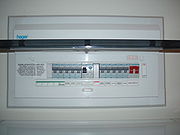
Consumer unit
Encyclopedia


Fuse (electrical)
In electronics and electrical engineering, a fuse is a type of low resistance resistor that acts as a sacrificial device to provide overcurrent protection, of either the load or source circuit...
or breakers
Circuit breaker
A circuit breaker is an automatically operated electrical switch designed to protect an electrical circuit from damage caused by overload or short circuit. Its basic function is to detect a fault condition and, by interrupting continuity, to immediately discontinue electrical flow...
, usually arranged in a single row. This is unlike a distribution board
Distribution board
A distribution board is a component of an electricity supply system which divides an electrical power feed into subsidiary circuits, while providing a protective fuse or circuit breaker for each circuit, in a common enclosure...
which has multiple rows of fuses or breakers and usually serves two or more locations, which may be split phase
Split phase
A split-phase electricity distribution system is a 3-wire single-phase distribution system, commonly used in North America for single-family residential and light commercial applications. It is the AC equivalent of the original Edison 3-wire direct current system...
, two phase
Two phase
Two-phase electrical power was an early 20th century polyphase alternating current electric power distribution system. Two circuits were used, with voltage phases differing by 90 degrees. Usually circuits used four wires, two for each phase. Less frequently, three wires were used, with a common...
, two phases taken from three phase, or three phases.
A consumer unit fitted with just fuses is often referred to as a "fuse box".
UK
"Consumer Unit (may also be known as a consumer control unit). A particular type of distribution board comprising a type-tested co-ordinated assembly for the control and distribution of electrical energy, principally in domestic premises, incorporating manual means of double-pole isolation on the incoming circuit(s) and an assembly of one or more fuses, circuit breakers, residual current operated devices or signalling and other devices proven during the type-test of the assembly as suitable for use."Examples
Modern consumer units (picture bottom right) usually use DIN-rail mount breakers. The rail and the shape of the front opening are standardized but the busbarBusbar
In electrical power distribution, a bus bar is a strip of copper or aluminium that conducts electricity within a switchboard, distribution board, substation or other electrical apparatus....
arrangements are not. Therefore mixing of brands should generally be avoided and, where unavoidable, care should be taken to ensure that the breaker chosen is a good fit for the busbars.
Generally a "split load" arrangement is used with some circuits protected by the RCD and others not.
The box pictured top-right is a "Wylex standard" fitted with rewirable fuses. These boxes can also be fitted with cartridge fuses or miniature circuit breaker
Circuit breaker
A circuit breaker is an automatically operated electrical switch designed to protect an electrical circuit from damage caused by overload or short circuit. Its basic function is to detect a fault condition and, by interrupting continuity, to immediately discontinue electrical flow...
s (MCBs). This type of consumer unit was very popular in Britain
United Kingdom
The United Kingdom of Great Britain and Northern IrelandIn the United Kingdom and Dependencies, other languages have been officially recognised as legitimate autochthonous languages under the European Charter for Regional or Minority Languages...
until 2001 when wiring regulations mandated residual current device (RCD) protection for sockets that could "reasonably be expected to" supply outdoor equipment (BS7671:2001, ISBN 0-86341-373-0). There were a number of similar designs from other manufacturers but the Wylex ones are by far the most commonly encountered and the only ones for which fuseholders/breakers are still commonly available.
RCD protection types
With the introduction of the recent 17th Edition IEE Wiring Regulations consumer units in the UK must provide RCD protection to all cables embedded in walls excepting high integrity circuits such as those for burglar alarms or smoke alarms.Consumer units have different methods of protecting circuits. A dual split-load consumer unit can be arranged as follows:
RCD 1
- Upstairs Lights,
- Downstairs Final Ring Main,
- Garage Sockets,
- Shower
RCD 2
- Downstairs Lights,
- Upstairs Sockets,
- Cooker,
- Heating,
By alternating the circuits like this, power will always be present on one floor if either RCD trips out.
Another way to protect circuits under the 17th Edition IEE Wiring Regulations is by fitting Residual Current Circuit Breaker With Overload (RCBOs) to every circuit although this can be a very costly method.
Some older systems such as those that use MK or old MEM Consumer Units that used fuses had one fuse per spur so for instance:
- Upstairs Lights Fuse 1
- Upstairs Sockets Fuse 2
- Downstairs Lights Fuse 3
- Downstairs Sockets Fuse 4
etc..

